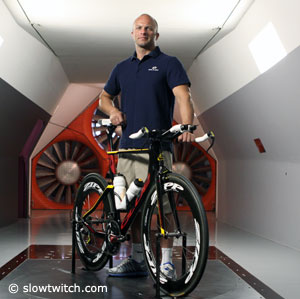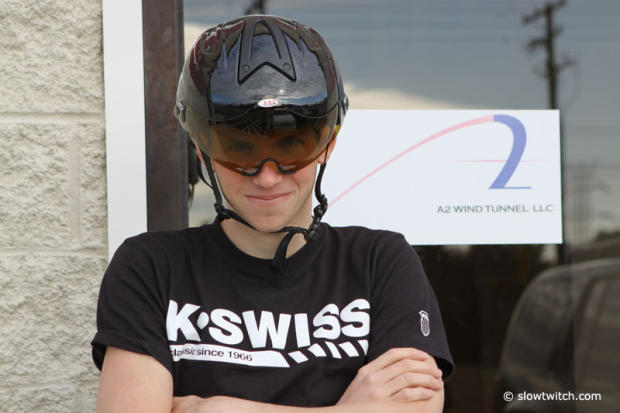Introducing Dave Salazar of A2
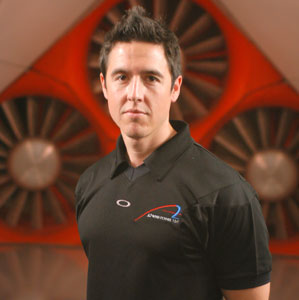
Dave Salazar has been involved with the Aerodyn / A2 wind tunnel for quite some time now but with the recent departure of Mike Giraud he stepped up to handle the bike program. Slowtwitch had a few words with the man to find out about the new challenges.
Slowtwitch: Did you have a good 4th of July weekend?
Dave: I had a great 4th of July weekend. As busy as it is with any racing industry right now, it’s nice to have a long 3-day weekend to get away from the hectic work schedule and unwind a little with some R&R. Mine was spent mostly on Lake Norman enjoying some wake surfing, spending time with friends, and I even managed to get in a bike ride.
ST: It seems you needed the long weekend because apparently you'll be a busy man this summer.
Dave: We have been very busy at both of our tunnels this year. I still work at AeroDyn part time and have just finished some R&D for testing Indy cars at that tunnel. I worked extensively with one of the Indy car teams for several months to design & fabricate a mounting system to allow testing in the AeroDyn facility. We have successfully tested and correlated the data for the Indy car and are now beginning to move forward with that program.
Now that that project is completed I have my normal A2 duties with the racecar testing, but since Mike Giraud’s departure I have also just recently inherited the entire bicycle testing program as well. So now begins the learning curve of working with teams, individual riders and manufacturers, which I am very excited about. In the past few weeks I have had a couple of bicycle manufacture tests now under my belt and it’s been interesting to get to work with new people in a new industry (new to me).
ST: You actually have been with the Aerodyn/A2 group for a quite a while now. How did you get your start there?
Dave: I started working at AeroDyn back in October of 2004, so this fall will be 7 years with the tunnels. It’s one of those stories of; I was in the right place at the right time. I grew up racing moto-cross and shifter karts and knew that working in the racing industry was something I wanted to do as career. After I realized how expensive it would be to try in get to a top level as a driver I decided to go to school for an Engineering degree at New Mexico State University and position my self to a path that would help lead me here. Working for a local race team while going to school gave me the experience I needed to finally come out and look for a job after Collage. One of my good Friends JR Patton who I had help race from back home was out here running in the NASCAR truck series and I came out for a month to lived on his couch as I passed out resumes to all the NASCAR teams. In this industry, as the case with most racing industries you really need to know someone to get a foot in the door as I quickly learned.
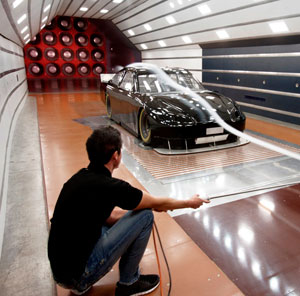
More than working for a race team however I really had an interest in aerodynamics testing in a wind tunnel and that was my first choice because instead of working at one team I would get to work with all of them. The day I walked in to AeroDyn they had recently had a meeting about hiring a 3rd operator since they were running 24 hours a day, 5 days a week. I was picked out of several possible, more experienced candidates so I have to thank the Man above for looking out for me and getting the opportunity to do something I love to do every day. There have only been 5 full time operators at AeroDyn since opening in 2003 so I am one of a very short list.
ST: When did bikes get first tested in the A2 tunnel and how did that come up?
Dave: I was still working at AeroDyn during the initial start of the bike program (2007) so I was not a part of the preliminary talks at A2, but I think one of the local bike shops had inquired about if we had the capability for testing cyclist. We did some research and found there could be a market for this capability if we could design and integrate a new system in with what we currently had, which was more difficult since we were not able to start from a blank sheet of paper. Instead, we had to work around a number of hurdles to get the system to work well with a tunnel designed for full-size racecars. Coincidently, Mike Giraud was working at this bike shop and worked with A2 on this process before we hired him full time. Since none of us here knew anything about bicycles his expertise was utilized and I work along side him to design our testing platform that we currently use today. Along with help from our team at AeroDyn Chris Osetek (programming code), Gary Eaker, Gary Romberg (aero consultant), Steve Dickert (electronics) we were able to pull off a system that works really well with our tunnel. We announce at the end of 2008 the capability to test bicycles.
ST: We already mentioned that Mike Giraud recently left his job at A2 to work for one of A2's customers. Was that very surprising to you or did you think that might eventually happen?
Dave: It wasn’t a surprise because Mike has such a vast knowledge of the bike industry and has such a good relationship with all of the people in it that in the back of my mind I knew someday an opportunity could come along for him. I was however taken a bit off guard because that is not a position you could just fill with anyone because of the training involved plus the background you would have to possess. Mike did an excellent job making the A2 bike program what it is today, and I hated to see him go, but at the same time I know it’s a great opportunity for him and I think that he will do great at his new company and wish him the best. I will also get to work with him now as a customer so that is something I’m looking forward to as well.
ST: You just hired Jim O'Brien to assist you in the tunnel. Can you tell us more about him and what exactly his role will be?
Dave: The last thing we wanted to do was shut down the bike program for any period of time so we could find a replacement, which we would then have to train how to run the tunnel for bicycle testing. What made the most sense to us was to have me run the wind tunnel side of things since I have over 8,000 hours testing and team with someone who would be there to support all of the fit/mechanical aspects during athlete tests. After tossing a few names around, Jim O’Brien made the most sense for a successful combination to join the A2 bicycle program. With Jim’s knowledge of the industry, his history, expertise in fitting cyclist and the fact that he is 25 minutes down the road makes it a wining combination. I have known Jim for the past several years and am really eager to work with him at A2.
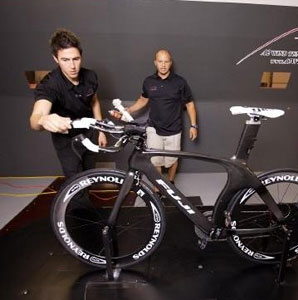
ST: So we are clear, it does sound like the individual athlete testing will continue in addition to the bike industry sessions. Is that correct?
Dave: Absolutely. With Jim O’Brien and myself working together, the athlete testing will still continue and A2 we will still offer a great facility for individual athletes to come test.
ST: During our recent visits we noticed a mechanical platform "in the making." Is that something that'll be in place some time soon and will that change the amount of yaw angles you'll test there?
Dave: I really hope to have something to announce about it very soon. We in fact do have a new platform in the works and mechanically it’s about finished, but now we have to get it calibrated and commissioned for use in the tunnel, which has taken longer than expected. The good news for A2 is we have been really busy testing in 2011, but the bad news is with all of the testing it is very difficult to schedule blocks of time needed to have the new rig in the tunnel for calibration. This new system will now have automated yaw capabilities that will make the manufacture testing more efficient, precise and will cut down on the time it takes to run a yaw sweep dramatically.
ST: The question often comes up in our forum what the minimum time is an individual ought to book in the tunnel. What are your thoughts along those lines?
Dave: You can get a good baseline and number of changes done in an hour, but we like to recommend to plan on at least 1.5 to 2 hours of tunnel time for a thorough test. Of course this is heavily based on the rider and not all riders test the same. Some might find that big improvement in an hour’s time where others it is more difficult to find what is working best aerodynamically as well as physically for their body type. Unfortunately, there is no perfect mold or magic number for time, but instead it’s finding the right combination for each athlete.
ST: Anything else?
Dave: You can get in touch with us right here


